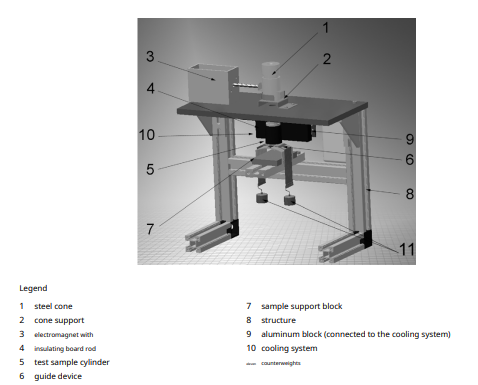DETERMINATION OF HEAT TRANSMISSION BY CONTACT THROUGH PROTECTIVE CLOTHING OR ITS CONSTITUENT MATERIALS DUE TO THE FALL OF SMALL CYLINDERS
PART 2: TEST METHOD USING CONTACT HEAT PRODUCED BY FALLING SMALL CYL
DETERMINATION OF HEAT TRANSMISSION BY CONTACT THROUGH PROTECTIVE CLOTHING OR ITS CONSTITUENT MATERIALS DUE TO THE FALL OF SMALL CYLINDERS
PART 2: TEST METHOD USING CONTACT HEAT PRODUCED BY FALLING SMALL CYL
Protective clothing designed to protect welders is exposed to high-temperature particles generated at the point of welding and projected nearby. These hot particles are small splashes of molten metal, sparks, and slag. When small splashes of molten metal are dispersed, they transfer heat to the atmosphere, oxidize, and begin to solidify.
The test method described in this part of ISO 12127 makes it possible to evaluate this heat transfer when a hot steel cylinder, simulating a small hot particle, comes into contact with the material. In addition, this method allows to evaluate the carbonization and the formation of holes in the material.
This part of ISO 12127 describes the test method that allows to evaluate the heat transfer, and the behavior of materials used in protective clothing when hit by small particles metal projections at high temperature, especially when these are trapped. in the folds of clothing in work situations.
The results obtained with this method allow the comparison of the behavior of different materials subjected to the same standardized test conditions.
They do not allow drawing conclusions about the behavior regarding the contact of large splashes of molten iron or other metals, nor predict the behavior of complete garments under industrial conditions.
This test method consists of two phases, which are carried out in order.
The first phase of the method consists in dropping a hot steel cylinder onto a point of the test sample located horizontally, and verifying the formation of a hole.
The second phase consists of measuring the maximum temperature difference of the materials that have passed the first phase.

The test samples must have minimum dimensions of (180 × 25) mm and must be taken from points more than 20 mm from the edges of the piece of material, in an area free of defects.
When the warp/weft direction cannot be determined, samples should be taken in two perpendicular directions.
For phase 1, cut at least 4 samples, 2 in the weft direction and 2 in the warp direction.
For phase 2, cut at least 6 samples, 3 in the weft direction and 3 in the warp direction.
At each end of the sample a hem will be made to allow the installation of the counterweights. The stitch patterns are measured without the tension of the counterweights. The necessary size for the stitch samples must be taken into account since they will be used without counterweights.
Phase 1: Hole formation test
The support block will be used without the calorimeter. The refrigeration system is not necessary at this stage. Proceed according to points a) to c), e), f) and i) to k). this procedure will be repeated until all four samples have been tested. The material is considered to have failed the test if hole formation is found in any of the samples, in which case the phase 2 test is not necessary.
Phase 2: Temperature difference test
The support block will be used with the calorimeter and the refrigeration system. Proceed according to points a) to k) for the six samples cut in two perpendicular directions.
This test standard does not have requirements but they can be taken into account according to the requirements according to EN ISO 11612:2015.

This website uses cookies so that we can provide you with the best user experience possible. Cookie information is stored in your browser and performs functions such as recognising you when you return to our website and helping our team to understand which sections of the website you find most interesting and useful.
Strictly Necessary Cookie should be enabled at all times so that we can save your preferences for cookie settings.
If you disable this cookie, we will not be able to save your preferences. This means that every time you visit this website you will need to enable or disable cookies again.
This website uses Google Analytics to collect anonymous information such as the number of visitors to the site, and the most popular pages.
Keeping this cookie enabled helps us to improve our website.
Please enable Strictly Necessary Cookies first so that we can save your preferences!